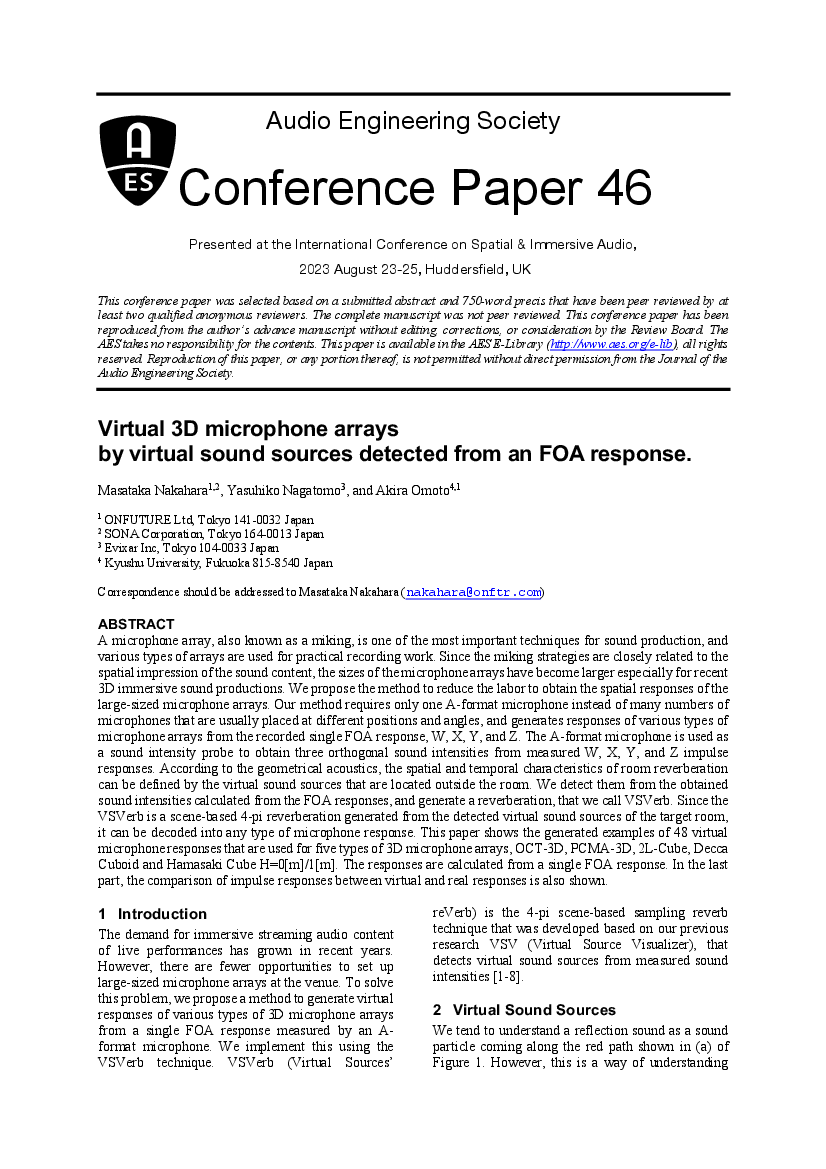Home / Publications / E-library page
You are currently logged in as an
Institutional Subscriber.
If you would like to logout,
please click on the button below.
Home / Publications / E-library page
Only AES members and Institutional Journal Subscribers can download
A microphone array, also known as a miking, is one of the most important techniques for sound production, and various types of arrays are used for practical recording work. Since the miking strategies are closely related to the spatial impression of the sound content, the sizes of the microphone arrays have become larger especially for recent 3D immersive sound productions. We propose the method to reduce the labor to obtain the spatial responses of the large-sized microphone arrays. Our method requires only one A-format microphone instead of many numbers of microphones that are usually placed at different positions and angles, and generates responses of various types of microphone arrays from the recorded single FOA response, W, X, Y, and Z. The A-format microphone is used as a sound intensity probe to obtain three orthogonal sound intensities from measured W, X, Y, and Z impulse responses. According to the geometrical acoustics, the spatial and temporal characteristics of room reverberation can be defined by the virtual sound sources that are located outside the room. We detect them from the obtained sound intensities calculated from the FOA responses, and generate a reverberation, that we call VSVerb. Since the VSVerb is a scene-based 4-pi reverberation generated from the detected virtual sound sources of the target room, it can be decoded into any type of microphone response. This paper shows the generated examples of 48 virtual microphone responses that are used for five types of 3D microphone arrays, OCT-3D, PCMA-3D, 2L-Cube, Decca Cuboid and Hamasaki Cube H=0[m]/1[m]. The responses are calculated from a single FOA response. In the last part, the comparison of impulse responses between virtual and real responses is also shown.
Author (s): Nakahara, Masataka; Nagatomo, Yasuhiko; Omoto, Akira
Affiliation:
ONFUTURE Ltd, Tokyo 141-0032 Japan; SONA Corporation, Tokyo 164-0013 Japan; Evixar Inc, Tokyo 104-0033 Japan; Kyushu University, Fukuoka 815-8540 Japan; ONFUTURE Ltd, Tokyo 141-0032 Japan
(See document for exact affiliation information.)
Publication Date:
2023-08-06
Import into BibTeX
Session subject:
Paper
Permalink: https://aes2.org/publications/elibrary-page/?id=22172
(3846KB)
Click to purchase paper as a non-member or login as an AES member. If your company or school subscribes to the E-Library then switch to the institutional version. If you are not an AES member Join the AES. If you need to check your member status, login to the Member Portal.

Nakahara, Masataka; Nagatomo, Yasuhiko; Omoto, Akira; 2023; Virtual 3D microphone arrays by virtual sound sources detected from an FOA response. [PDF]; ONFUTURE Ltd, Tokyo 141-0032 Japan; SONA Corporation, Tokyo 164-0013 Japan; Evixar Inc, Tokyo 104-0033 Japan; Kyushu University, Fukuoka 815-8540 Japan; ONFUTURE Ltd, Tokyo 141-0032 Japan; Paper 46; Available from: https://aes2.org/publications/elibrary-page/?id=22172
Nakahara, Masataka; Nagatomo, Yasuhiko; Omoto, Akira; Virtual 3D microphone arrays by virtual sound sources detected from an FOA response. [PDF]; ONFUTURE Ltd, Tokyo 141-0032 Japan; SONA Corporation, Tokyo 164-0013 Japan; Evixar Inc, Tokyo 104-0033 Japan; Kyushu University, Fukuoka 815-8540 Japan; ONFUTURE Ltd, Tokyo 141-0032 Japan; Paper 46; 2023 Available: https://aes2.org/publications/elibrary-page/?id=22172